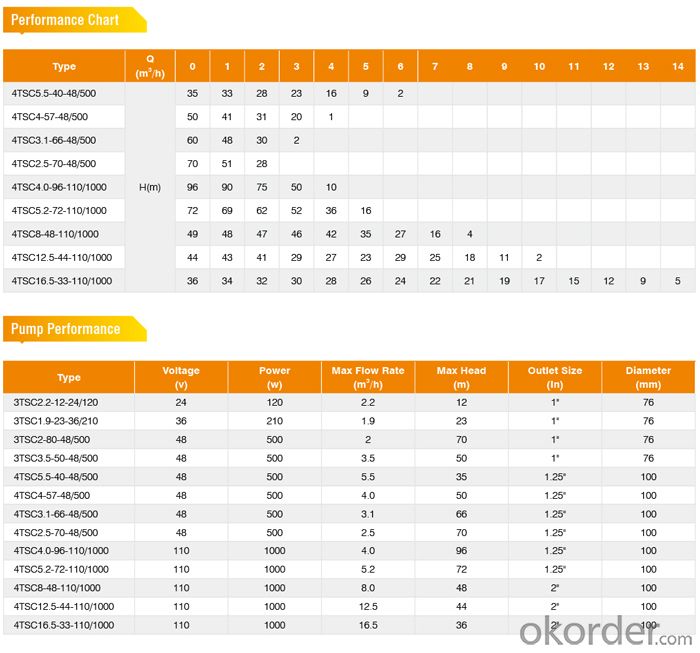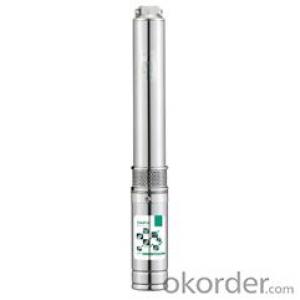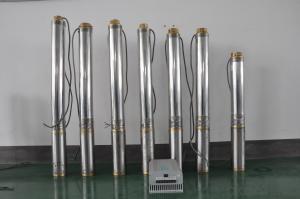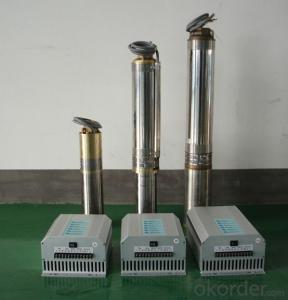3TSC/4TSC SOLAR PUMP stainless steel CE, solar panel
- Loading Port:
- Shanghai
- Payment Terms:
- TT OR LC
- Min Order Qty:
- 50 pc
- Supply Capability:
- 100000 pc/month
OKorder Service Pledge
OKorder Financial Service
You Might Also Like
1.APPLICATION AREA:This project products are mainly used in dry region for irrigation of agriculture, It can be used for drinking water and
living water. The living condition could be much improved. It also can be used for fountains.2.MATERIAL OF PARTS:Outlet: stainless steel
Pump body: stainless steel
Motor body: stainless steel
Bearing: C&U
3.ADVANCED TECHNOLOGY:1.Application innovation
Compared with the traditional alternating current machine, the efficiency is improved 25% by the permanent magnetism, direct current, brushless, non-sensor motor.
2.Technics innovation
Adopt double plastic package for rotor and stator, motor insulation≥300MΩ, the motor security was much improved.
3.Structure innovation
Oil filling, convenient installation and environmental protection4.HIGHLIGHTSa.Energy-saving and environment-protected green products
b.High technique products adopting MPPT and DSP chip technique.
c.100% copper wire, cold-rolled silicon steel sheet
d.CE certificate
e.Advanced three phase brushless DC motor
f.Stainless steel 316 screws
g.3 years warranty5.PRINCIPLE OF OPERATION:Solar panel collects sunlight→DC electricity energy → solar controller(rectification,stabilization,amplification,filtering)→available DC electricity→(charge the batteries)→pumping water6.ADVANTAGES OF SOLAR PUMP SYSTEM:A.It is easier and more widely used than any other dynamoelectric driven pumps.
B.It is more economical and more environmentally friendly.7.MODEL SELECTION:a.The power of solar panel = power of pump ×1.3
The voltage of solar panel = the voltage of pump
The controller should be matched
b.Select the batteries according to the following formulas:
The use hour of battery =
The battery capacity ÷(the machine power÷the battery voltage)×0.6 For example,the machine power is 200W, the battery
capacity is 100AH,the voltage is 12V,and the battery is fully charged,then the use hour is:100÷(200÷12)×0.6=3.6hours
c.The battery capacity=
the use hour ÷0.6×(the machine power÷the battery voltage) For example,the machine power is 200W,the battery voltage
is 12V,and the battery need to be used for 3.6hours,then the battery capacity is:3.6÷0.6×(200÷12)=100AH


- Q:Can a solar pump be used for water supply in off-grid schools?
- Yes, a solar pump can be used for water supply in off-grid schools. Solar pumps are an excellent option for off-grid locations, as they rely on solar energy to power the pump, eliminating the need for grid electricity. This makes them a sustainable and cost-effective solution for water supply in areas where electricity is not readily available. Solar pumps can be used to extract water from wells, boreholes, or other water sources, and they can deliver water to storage tanks or directly to the school's water distribution system. They are particularly suitable for off-grid schools as they can operate independently without the need for complex and expensive infrastructure. Solar pumps are also environmentally friendly, as they do not require any fuel or produce any greenhouse gas emissions during operation. They are low-maintenance and have a long lifespan, making them a reliable and sustainable solution for water supply in off-grid schools. Furthermore, solar pumps can be equipped with battery storage systems, allowing them to operate even during cloudy days or at night. This ensures a continuous water supply to the school, regardless of weather conditions or time of day. In conclusion, solar pumps are a viable and efficient option for water supply in off-grid schools. They offer a sustainable, cost-effective, and reliable solution, ensuring access to clean water for students and staff in remote areas.
- Q:What is the average cost of a solar pump?
- The average cost of a solar pump can vary depending on factors such as the size, capacity, and brand. However, a rough estimate for a typical solar pump can range from $1,000 to $5,000.
- Q:Are there any government incentives or subsidies available for solar pump installations?
- Yes, there are government incentives and subsidies available for solar pump installations in many countries. These incentives aim to promote the use of renewable energy sources, such as solar power, and reduce dependence on traditional energy sources. These incentives can include tax credits, grants, feed-in tariffs, and low-interest loans, which can significantly reduce the upfront costs of installing a solar pump system. It is advised to check with local government agencies or renewable energy organizations to determine the specific incentives and subsidies available in your region.
- Q:Are there any government incentives or rebates available for installing solar pumps?
- Yes, there are government incentives and rebates available for installing solar pumps. These incentives vary by country and region, but many governments offer financial support or tax credits to encourage the adoption of renewable energy systems such as solar pumps. It is recommended to check with local government agencies or renewable energy organizations to gather specific information on available incentives and rebates in your area.
- Q:Are there any maintenance requirements for solar pumps?
- Yes, there are maintenance requirements for solar pumps. While solar pumps are generally low maintenance compared to traditional pumps, regular maintenance is still necessary to ensure their optimal performance and longevity. Some of the maintenance requirements for solar pumps include: 1. Cleaning: Regularly clean the solar panels to remove any dust, dirt, or debris that may accumulate on the surface. This will help maximize the solar panels' efficiency and ensure they generate enough power to operate the pump. 2. Inspections: Periodically inspect the pump system, including the motor, pump, and connections, to check for any signs of damage or wear. Look for loose or damaged wires, leaks, or any other issues that may affect the pump's performance. 3. Lubrication: Depending on the type of solar pump, lubrication may be required for the moving parts. Follow the manufacturer's guidelines and recommendations for lubricating the pump to ensure smooth operation. 4. Battery maintenance: If the solar pump includes a battery backup system, regular battery maintenance is essential. This may involve checking the battery levels, cleaning the battery terminals, and replacing batteries if necessary. 5. Professional servicing: It is advisable to have a professional service and inspect the solar pump system at least once a year to ensure everything is in good working order. They can perform more in-depth checks, provide any necessary repairs or replacements, and offer recommendations for optimal performance. By following these maintenance requirements, solar pump owners can ensure their systems operate efficiently and effectively, reducing the risk of breakdowns and extending the lifespan of the pump.
- Q:Are solar pumps suitable for use in construction sites?
- Yes, solar pumps are suitable for use in construction sites. They are highly efficient, cost-effective, and environmentally friendly alternatives to traditional fuel-powered pumps. Solar pumps can provide a reliable water supply for various construction activities such as concrete mixing, dust suppression, and irrigation. Additionally, they can be easily installed and require minimal maintenance, making them an ideal choice for construction sites in remote or off-grid locations.
- Q:What are the different types of solar pumps?
- There are three main types of solar pumps: submersible solar pumps, surface solar pumps, and floating solar pumps. Submersible solar pumps are installed underwater and are commonly used for irrigation and water supply in remote areas. Surface solar pumps are placed above the water surface and are suitable for small-scale irrigation or domestic use. Floating solar pumps are designed to float on the water and are typically used for ponds, lakes, or reservoirs.
- Q:Can a solar pump be used for water circulation in a cooling tower or industrial process?
- Yes, a solar pump can be used for water circulation in a cooling tower or industrial process. Solar pumps are designed to harness the energy from the sun and convert it into mechanical energy to circulate water. They are commonly used in various applications, including irrigation, water supply, and cooling systems. In the case of a cooling tower or industrial process, a solar pump can be utilized to circulate water within the system. The pump can draw water from a source, such as a reservoir or a well, and then distribute it throughout the cooling tower or industrial process, ensuring a continuous flow of water for cooling or other industrial needs. The advantages of using a solar pump in these applications are numerous. Firstly, solar pumps are eco-friendly as they derive their power from the sun, reducing dependence on fossil fuels and minimizing greenhouse gas emissions. This aligns with the growing trend towards sustainable and renewable energy sources. Secondly, solar pumps often have low operating costs as they do not require electricity from the grid. Once the initial investment in the solar pump system is made, the ongoing operational expenses are minimal, resulting in cost savings over time. Additionally, solar pumps are typically reliable and require minimal maintenance. They are designed to withstand harsh environmental conditions and can operate efficiently even in remote locations where access to electricity may be limited. In summary, a solar pump can certainly be used for water circulation in a cooling tower or industrial process. It offers the benefits of sustainability, cost-effectiveness, and reliability, making it a viable option for various industrial applications.
- Q:Can a solar pump be used for geothermal heating or cooling systems?
- No, a solar pump cannot be directly used for geothermal heating or cooling systems. Geothermal systems use the Earth's natural heat to provide heating or cooling, whereas solar pumps are designed to harness energy from the sun. The technologies and mechanisms involved in these systems are different, making them incompatible for direct use with each other.
- Q:Can a solar pump be used for mining applications?
- Indeed, mining applications can make use of a solar pump. When it comes to pumping water or other fluids in mining operations, solar pumps offer both an eco-friendly and budget-friendly alternative. They have the ability to supply water for various mining processes, including dust suppression, ore processing, and equipment cooling. By employing photovoltaic panels, solar pumps convert sunlight into electrical energy, which in turn powers the pump. This eliminates the need for fuel or electricity, making them suitable for mining sites located in remote areas or with limited access to power grids. Moreover, solar pumps are self-sufficient and can be easily installed, maintained, and relocated as needed. Implementing solar pumps in mining applications not only reduces carbon emissions and operating costs, but also fosters sustainability within the mining industry.
1. Manufacturer Overview |
|
|---|---|
| Location | |
| Year Established | |
| Annual Output Value | |
| Main Markets | |
| Company Certifications | |
2. Manufacturer Certificates |
|
|---|---|
| a) Certification Name | |
| Range | |
| Reference | |
| Validity Period | |
3. Manufacturer Capability |
|
|---|---|
| a)Trade Capacity | |
| Nearest Port | |
| Export Percentage | |
| No.of Employees in Trade Department | |
| Language Spoken: | |
| b)Factory Information | |
| Factory Size: | |
| No. of Production Lines | |
| Contract Manufacturing | |
| Product Price Range | |
Send your message to us
3TSC/4TSC SOLAR PUMP stainless steel CE, solar panel
- Loading Port:
- Shanghai
- Payment Terms:
- TT OR LC
- Min Order Qty:
- 50 pc
- Supply Capability:
- 100000 pc/month
OKorder Service Pledge
OKorder Financial Service
Similar products
New products
Hot products
Related keywords


























